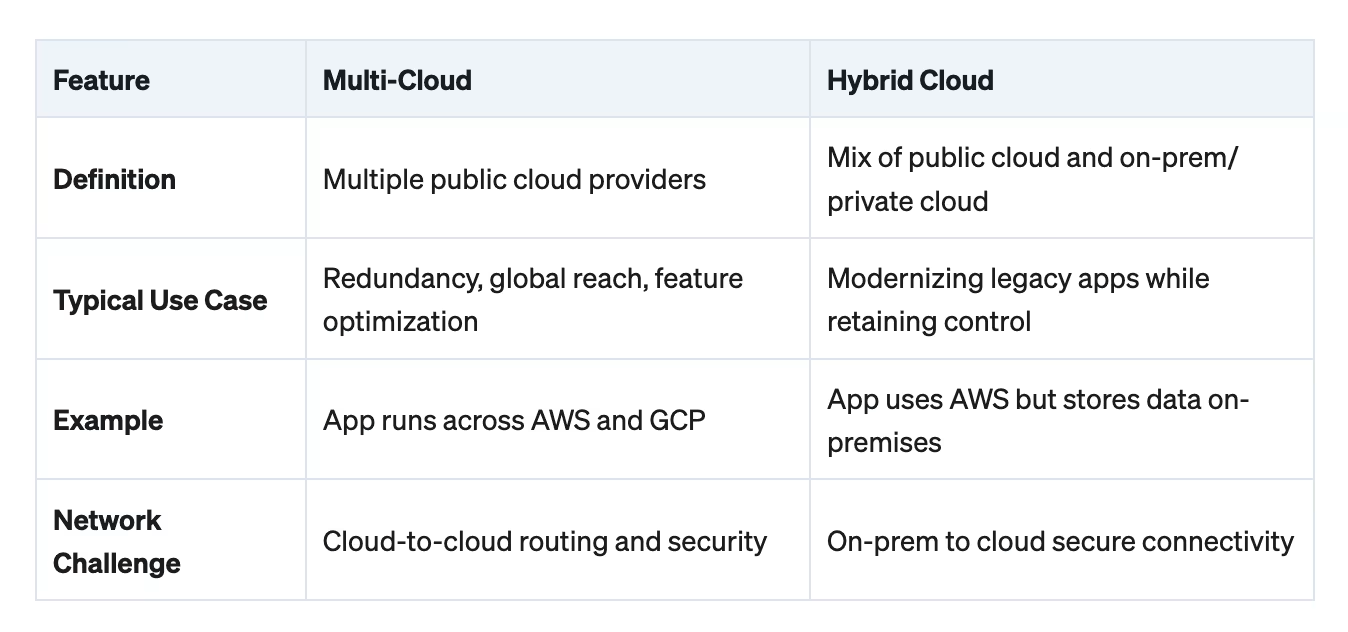
As organizations increasingly adopt digital-first strategies, many are moving beyond single-cloud deployments into multi-cloud environments. These architectures provide flexibility, reduce vendor lock-in, and allow teams to choose best-of-breed services across multiple providers. But while the benefits of multi-cloud are clear, the networking complexity it introduces is often overlooked—and can quickly become a bottleneck for scale, performance, and security.
This article breaks down what multi-cloud is, how it compares to hybrid cloud, and explores the unique networking challenges and solutions involved—especially when it comes to connecting workloads, users, and data across clouds.
Multi-cloud refers to an IT strategy where an organization uses two or more public cloud providers—such as AWS, Microsoft Azure, Google Cloud Platform (GCP), or Oracle Cloud—to run applications, store data, or deliver services.
Unlike traditional single-cloud architectures, multi-cloud environments let you:
Critically, each cloud provider operates in its own virtual network, which means that applications and services running in separate clouds require explicit connectivity and routing configurations to communicate.
While often used interchangeably, multi-cloud and hybrid cloud are distinct:

Hybrid cloud often uses VPNs or Direct Connect-like services to bridge the corporate network with the cloud. In multi-cloud, however, cloud-to-cloud communication introduces a new layer of complexity.
Connecting multiple cloud providers is not as simple as peering two VPCs. Each provider uses unique networking models, address schemes, and security policies. Here are the most common approaches:
You can deploy VPN gateways in each cloud and establish IPsec tunnels between them.
Use managed services like:
These services offer global backbones but generally work within a single provider. Cross-cloud integration often still requires third-party solutions.
Network-as-a-Service (NaaS) providers like Megaport, Equinix Fabric, or Alkira enable multi-cloud transit routing.
Some enterprises build custom overlays using SDN to route traffic through unified control planes.
Emerging solutions like noBGP offer programmable, deterministic multi-cloud routing without relying on public IPs, VPN tunnels, or manual NAT configuration.
A well-architected multi-cloud network needs to be secure, scalable, and programmable—ideally using centralized routing policies and end-to-end encryption.
A multi-cloud database is a distributed data platform that spans multiple cloud providers. These databases are designed to:
Running a multi-cloud database requires low-latency, secure connections between cloud regions—often through private links or high-speed VPNs. You’ll also need:
Multi-cloud isn’t just about running apps in more than one cloud—it’s about connecting those applications and data across providers with minimal friction. While cloud vendors offer powerful tools individually, connecting services between them introduces architectural challenges that legacy networking was not built to handle.
To succeed in a multi-cloud world, teams must rethink connectivity: from static VPNs and peering to more dynamic, programmable, and policy-driven models. Whether you’re managing traffic between AWS and GCP, building a global app architecture, or running a multi-cloud database, your networking layer must evolve just as fast as your compute.